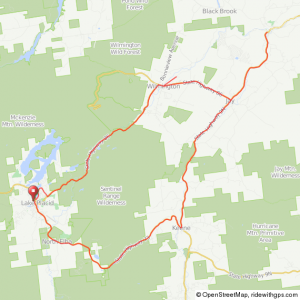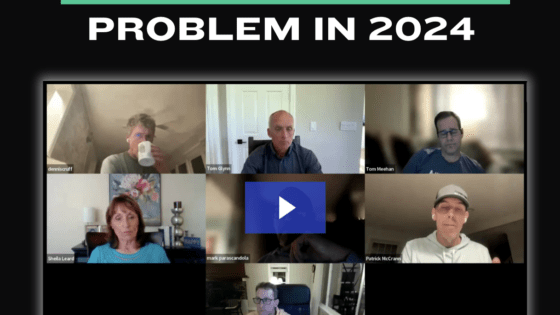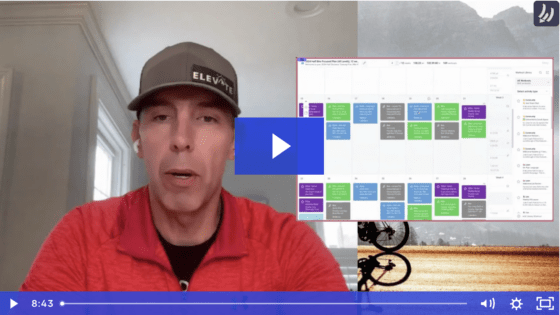Endurance Nation has a long history on the Ironman® Lake Placid course: Coach Patrick has raced the event seven times, qualifying for Hawaii three of those occasions. Patrick’s personal best is a 9:54; he has held a training camp on the course every year since 2002, and he’s attended almost every edition of the race. Finally TeamEN has historically had between 25 and 75 athletes at the race every year since 2008.
We’d like to share that experience with you with these consolidated tips and resources specific to the Lake Placid course.
Weather
In our opinion, Lake Placid has the most consistently unique weather of any US Ironman® course — being nestled in the mountains with a full 50% of the course at a different elevation can mean multiple weather systems in the same day. In short, you need to be prepared to race in any conditions.
That said, don’t sweat the weather report until about Friday of race week. Again, we’ve seen the weather change dramatically in the last fews days before the race and the forecast for Sunday won’t be accurate until Saturday morning. Likewise, if you see a forecast for rain, it could only be a passing shower that unleashes some humidity…but it could be a torrential downpour…only race day will tell!
Timing of the Event
The timing of an event should the #1 criteria you use for selecting what Ironman to train for and race — not hills, not weather, not water temperature, but does rather the timing of the event work for you.
Will you have cooperative weather and hours of daylight available for training, especially in the last 8-10wks of your work up?
Do not underestimate the challenges of long, long rides on the trainer necessitated by choosing a sub-optimal combination of race date and your typical weather conditions in your final workup.
So the combination of the variable weather and the July date of the race means that you need to have time to acclimate to the heat, in the event Placid serves up a hot day. Thankfully, the weather and daylight savings intersect before early May, when your training begins to ramp up. Below are our notes on how all of this shakes out for US-based athletes:
- Southeast: Timing of the race is good, with regards to hours of daylight, the ability to train outside, and to acclimatize to the potential heat of the race.
- Northeast: Timing is…just right. This is really the earliest you can race and be 100% ready, plus it’s a hometown race for most triathletes in the region.
- Midwest: See Northeast above.
- Northwest: Training outside = fair; acclimatize = not so good; logistics and travel costs = cost prohibitive.
- Southwest and West: No issues with hours of daylight, weather, and the ability to train outdoors. More than anything else, the sheer distance of the race makes it rank a bit lower.
The Venue
Travel costs and logistics: Placid is about a 5-hour drive from almost anywhere. No joke! So even a flight will only put you into a rental car that you need to drive for a few more hours.
Lodging: ALL hotels in the area are booked (Placid is small) and rates are jacked up. You might be able to book a more affordable hotel in Saranac Lake and drive 30′ each way to the race.
Parking: Rather than drive around and around trying to find a spot on the street, just park at the city lot downtown. The parking rates are very affordable relative to big city rates.
Dining: Lots of options to suit just about anyone, especially the beer afficianados. Be sure to visit the Placid Pub for a taste of the local brew scene!
Now, let’s get on with the race!
The Swim
Practice Swims: The course has buoys out there all week (most of the year, in fact) but it won’t be fully setup until sometime Friday. You’ll be able to swim in the lake before race day, just don’t over do it — those permanent buoys are actually longer than the race course! We recommend you swim an abbreviated loop, picking up landmarks for navigation on the opposite shore. Then bang a right, swim across, another right, and come back looking for more landmarks. It’s more important that you get a feel for the water conditions.
The Swim Start: From 1999 to 2013, the Lake Placid swim start had gained a reputation for being one of the most crowded in the sport. With nearly 3000 athletes all jammed into a narrow beach there was a LOT of contact. The permanent underwater cable made life easier, but still it was tough. With the new wave swim start protocol for the 2013 race, things wend much more smoothly for all save for the Pros, who only just finished their first lap right after the final Age Groupers entered the water. There is a “pro lane” to help them maintain their speed.
The Course: The Lake Placid swim is a two loop affair in Mirror Lake, from a beach start. You’ll swim directly out from shore about 800m, turn right and swim about 100m, turn right again and swim back towards the pier. You’ll go around it, exit the water, run over a timing mat, then run/swim out to the first buoy, repeat.
The Temps: The water temperature is pretty consistent in the upper 60s / low 70s. We recommend a full wetsuit. Some athletes opt to wear long john wetsuits, but it’s really your personal preference.
The Transition
Lake Place has one of the longer transitions in the sport. It’s basically a long run from the lake, up a street and into an oval concrete skating rink. Your bags are hung outside on racks (T1 on top, T2 on bottom), your bike is racked on shaded grass, and the changing tent is between them. By the time you exit transition at the mount line, you will have covered more than a 1/2 a mile!
The Bike (View Online Here)
Introduced in 2010, this is the 2nd permutation of the Lake Placid bike course. This is our breakdown of the course, how to ride it and what mistakes to avoid, as a description of one lap of the course:

Miles 0-8: Climbing Out of Town
This is your first chance to blow the entire race. IGNORE the hammerheads and others racing, be safe and just get out to the lake.
Same drill when you come back into town and start lap number two, but you’ll be much more tired.
Miles 8 to 35: Descent to TT Time
If you reference the bike course profile, you’ll see the descent and the rolling to flat sections of Keene, Upper Jay, Jay and Ausable Forks. The first lap is generally free, but by lap two the wind here is pretty significant and can really slow you down you have over-achieved early on.
Just sit down, relax, and get into a really nice groove. In our opinion, this 27-mile section, which you’ll do two times for a total of 54 miles, is essentially free. Just ride steady, ride your race, and ignore the other athletes around you.
Miles 35 to 42: The Crossing to Wilmington
After your “free” early miles you’ll turn right on Hwy 86 and effectively cross over to Wilmington before you start the true climb back into town. Right away you are slapped with a real solid climb — aka “Foundation Hill.” After a way-too-short descent you have two more short and steep climbs that will test your patience.
This is the section of the course that no one talks about — it’s lost in the elevation profile and it under-appreciated until the second lap where everyone who biked too hard too early are now wondering how they will ever make it back into town.
Miles 43 to 56: The Climb Back into Lake Placid
After a brief respite on Haselton Road, you will begin the process of riding back up to Lake Placid proper. This section starts off innocently enough until the road really pitches up to cross a river, and again at the Whiteface Mountain entrance and right after to the picnic area.
This early part of the climb is truly the worst, and is “only” four miles long. Then you have a respite past the High Falls Gorge, some rollers along the stone wall and then more speed with slight rollers though Mile 51. Then you begin the second half of the climb, working your way up to the top of “Poppa Bear Hill” and heading into town.
Truth be told, this climb can be fast if you work the speedy parts and ride the rest smart. If there’s a headwind coming down, then nothing can really help you, you’ll have to just get it done.
As you head into town and around the lake, you’ll pass the Bike Special Needs area and enjoy some really great support from the crowds.
The Run (View A Map Online Here)
The run course hasn’t changed in…well…forever. It’s a fair course with adequate ups, downs and flats such that most people can still run well if they aren’t nuked.
Miles 0-5.5, 14-18.5 = The Out
- Mostly downhill.
- Lots of spectator mojo in the first two miles and many, many athletes run much too fast here. Don’t be one of them!
- This section eventually turns rolling along the river.
- You’ll then flip it and run back.
- Enjoy the crowd support and the mojo as you leave transition then settle in for the run along the river.
Miles 5.5 to 12, 18.5 to 25.5 = The Back
Once you turn around on the River, you are running some flavor of up all the way back into town. This includes:
- The Ski Jump Hill; approximately 1/4 mile long right as you exit River Road.
- Townie Hill; approximately 1 mile long that takes you from Lisa G’s up to the Placid Brew Pub — this is the worst hill on the entire day.
- Even past the Pub, you still have a slight climb to the turn around there before heading back towards the start of lap two / the finish area.
- Just put your head down in the last 3 miles. The many climbs and twists in this section make it very difficult to maintain a sense of where you are relative to the finish line, even though you have to run right past it. Just. Keep. Moving.
Finish Line
Awesome! You’ll stay right to head to the finish, then enter the Olympic Oval and begin the half lap jog around towards the stands and the finish line. Enjoy and don’t forget to live it up in the chute!
TeamEN Race Reports and Podcasts:
We’ve found race reports to be extremely effective tools to teach our athletes how to race: TeamEN post their race reports, as well as their race and race rehearsal plans, in our forums for peer review from their comrades. The result is a very rich, team-wide knowledge base of race execution tips and a culture of athletes helping athletes learn now to race better.
Endurance Nation Blog: Lake Placid Race Report Archive
Endurance Nation Podcast Channel: Lake Placid Race Report Podcast Interviews
Racing Ironman? Attend Our FREE, LIVE Four Keys Talks!
Learn how to execute like a pro with our free Triathlon Execution Seminar
IRONMAN® is a registered trademark of World Triathlon Corporation, is not affiliated with Endurance Nation®, and does not endorse or sponsor our products, materials or events.





Leave a Reply